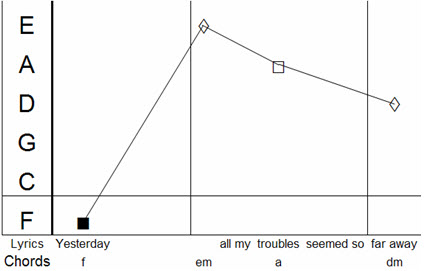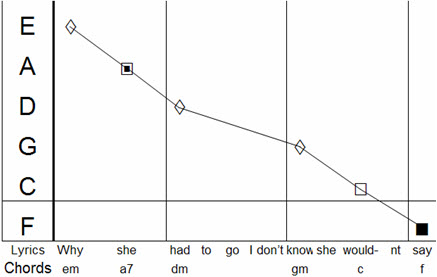Ok so now this song is stuck in my head, it got me thinking about relative minors. What would happen to this song if you swapped all the chords for their relative majors/minors. It is one of the simplest substitutions you can use so lets have a listen.
Firstly lets hear the original verse:. The chords reapeat around A-c#m-f#m-D.
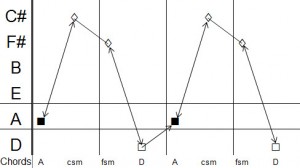
SeeChord chart
Now, if we swap all of those chords for their relative majors/minors, we get this instead:

SeeChord chart of "Somebody like you" with substituted chords.
However, there are some other chords that will serve just as well for relative majors and minors. We are often told that there is only one relative major or minor, but this is not the case. Take C major for example. Music theory tells us that the relative minor is A minor. Sure enough, their chords and scale are very similar, so it is easy to see the relationship. However, there is another minor chord very similar to C major, and tha is E minor. The similarities are not so exact in the scale, but for a chord substitution it is perfectly valid.
What happens to our tune if we substitute these chords instead?:
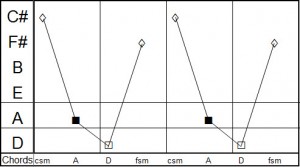
SeeChord chart of "Somebody like you" by Adele, with relative majors/minors
Neither of the new chord progressions sound quite right as we are so used to hearing the original, and the fact that the tune fits perfectly over the original chords. However if we could pick and choose from these substitutions…
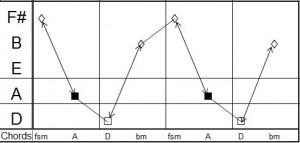
SeeChord Chart
In my opinion this sounds just as solid as the original sequence, even though none of the original chords appear in the same position. This shows the power of relative majors and minors and of substitutions. Many songs and songwriters use substituted chords to chage up their progressions. Give it a go, you might find that it creates that moment of magic you were looking for!
Ok so this is one of THE songs of the moment. Worth taking a minute to have a look at how the chords fit together. The chords for the verse and chorus are very similar:
Verse – A-c#m-f#m-D.
Chorus-A- E- f#m-D
Here is the sequence on a SeeChord chart of the verse:

SeeChord chart
This is a lovely example of how to use relative minors effectively. In my mind there are two ways of looking at this. This first, and perhaps most conventional would be to say that the relative minor of A is f#m. That would mean that the c#m chord is a way of using the strongest of all chord sequences, the falling fifth to get to the f#m chord. The D chord then provides the IV-I (or plagal) cadence that is a feature of so many rock and pop songs.
However, there is another, slightly more intruiging way of seeing this sequence. There is another minor chord that is closely related to A. In fact all major chords have two relative minors. In this case, the oter relative minor has been used, which is the c#minor chord. It is easy to see how closely related A major and c#minor are by looking at the notes in each chord:
A Major: A C# E
c#minor:G# C# E (inversion)
So we could just as validly say that the jump from A major to c#minor is a relative minor jump. This then leads nicely to the f#minor by a descending fifth. Then the leap from f#m to D is another of these alternative relative minor jumps.
Here is the Seechord chart for the chorus:
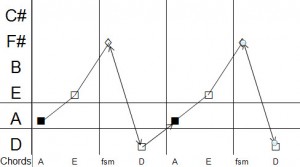
Here the c#minor chord has been replaced by the E major. A far more conservative choice, and the first time the V (5) chord has been heard. This Dominant chord provides more of a sense of security, not only because it is a major chord, but also because it helps to establish the tonic, A major. This reflects the lyrics, “Never mind I’ll find somebody like you” – bittersweet but optimistic.
Thought I would start off with the McCartney classic, Yesterday. It is hard to define a clear “verse” or “chorus” as both parts of the song have a very verse-like feel, with little repetition apart from the title or tagline, “Yesterday”. The most striking harmonic feature is the second chord of the song. Have a look at the following chart showing the jump from F to em…
Yesterday(1965)
An immediate and unexpected leap from F to em. Of course the harmony then falls through the fifths as we would expect. This is in fact a common jump (chromatic descending), but unusual so early in a progression.
The descending fifth sequence is then used again in the next part of the song.
Classic use of the descending fifths progression. This leads the ear to the root chord of F, giving a very satisfying sound when we get there. Notice that the end of this phrase ia a perfect cadence (C-F). This nicely finishes the chord progression. Earlier in the song (oh I believe in Yesterday) he used a plagal cadence (Bb-F) which has a harder edge.
Such simple chords, such a simple device, jumping up to the 7 chord, and falling back down through the fifths, such a sublime result.
For more Beatles song analysis and Beatles chords progressions follow this
link
Over the last 10 years I have been analysing chord progressions across all genres of music. On this blog I intend to regularly post my insights into these progressions, spending some time going into why they are unusual, or why they conform, which pieces are similar and which are truly original.
I would love to hear any feedback, or requests for songs or pieces you would like to understand better.
Most of my insights have been informed by SeeChord. Do have a look at the rest of the site if you want to find out how it can help you.
Joe Samuel
It is arguably the most popular song of all time, appearing in the top 10 of almost every top 10 song list ever. Bohemian Rhapsody by Queen needs no introduction. However, it does need analysing. How do those crazy chord progressions work? Does it obey the normal rules of songwriting? Was it ground breaking?
I hope I can answer all of those questions now I have looked at Bohemian Rhapsody through the eyes of SeeChord. I have made a little video of the results. Enjoy and let me know if you are now enlightened!
Bohemain Rhapsody analysed with SeeChord





